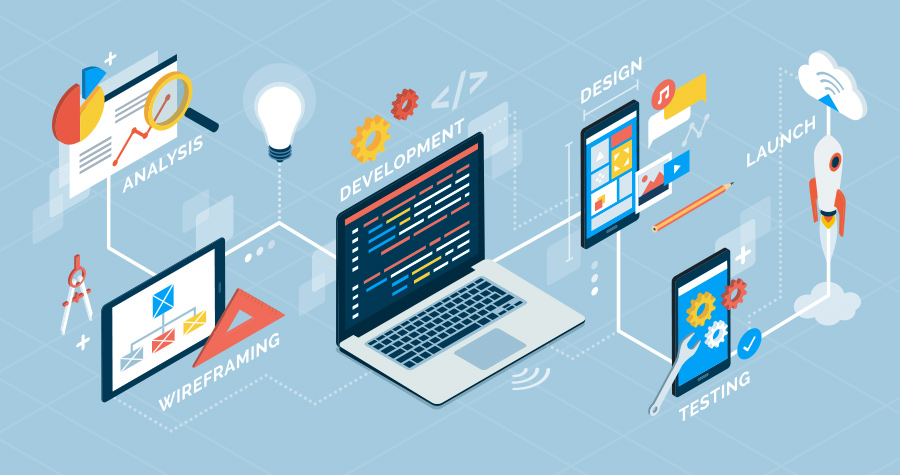 Developing a successful mobile app starts long before your teams write their first lines of code. It requires careful planning, and consideration of various factors that affect how well users and partners will respond to your new application.
Developing a successful mobile app starts long before your teams write their first lines of code. It requires careful planning, and consideration of various factors that affect how well users and partners will respond to your new application.
Product teams must effectively balance stakeholder priorities, user demands, and any outstanding technical restraints as they work towards launch. Plus, you need to conduct some pre-development research to ensure the functionality of your application will be well-received by its target market.
Before you dive into a mobile app development project, here are several proactive steps to take to ensure the best results:
#1 Conduct Market Research
Ahead of any detailed plans for your mobile app development project, take time to understand how it fits into your industry's current landscape. Market research informs your application's value proposition and key functionality, plus your marketing strategy as you approach the initial launch date. This research helps you:
-
Evaluate current offerings and competitors
-
Find the market gap(s) your app will fill
-
Create an effective solution to the problem you set out to solve
During your research, you'll uncover competitor analysis results. These findings — paired with your organization's internal priorities — help you define the primary goal of your application and your unique value propositions. With these results, you will be able to:
-
Avoid your competitors’ mistakes
-
Identify your audience's demands and expectations
-
Define your take on the problem your app will solve
In a market flush with app offerings, thorough research allows you to make data-driven decisions that will help your tool stand out.
#2 Define Your Value Proposition
With market research in hand, it's time to consult with internal stakeholders and product teams to consolidate data, business goals, and other insights into clear, measurable objectives — and a central value proposition.
Your application's unique value proposition (UVP) will guide you through ideation, planning, development, and launch. It ensures you solve a real pain point and serve your target audience effectively. Here are some questions that help define your UVP:
-
What's the primary functionality we need to deliver?
-
What need does this functionality serve?
-
What audience will benefit from this solution?
-
Why will they choose our solution over a competitor?
-
Which business goals will this application help us achieve?
The better you understand your target audience, the better you’ll be able to develop an app specifically tailored for them. Without a clear idea of who you're building the application for and why, your mobile app development project is simply a shot in the dark.
Whether B2B or B2C, your new application needs to be rooted in a central goal. Cutting-edge functionality or a sleek UI won't suffice if your product doesn't offer actual value to users.
#3 Choose a Platform
There are several technical details to define before your software engineers begin working on your new mobile app. Selecting a platform is one crucial decision you should make as early on as possible. Your choice — native, hybrid, or web — heavily impacts how you will develop and maintain the application over time.
As you consider your options, refer back to the market research you conducted and the UVP you defined in step two. In most cases, the core functionality of your app will heavily inform your choice of platform. You'll also factor in budget, time frame, and technical expertise in the programming languages of each available option. At a glance, there are a few core differences between native, hybrid, and mobile apps:
-
Native apps work well for heavy-duty tasks like mobile gaming or photo/video use. They are the most expensive to develop but easily findable in Apple and Android's app stores.
-
Web apps enable easy updates and don’t require access to the device’s native abilities. While they are affordable to develop, your users can't download them or customize their experience.
-
Hybrid apps deliver the best of both worlds by using the same code base for both platforms, making them ideal for most use cases, including productivity, utility, and enterprise apps.
Your choice in application type heavily informs the rest of your development, so it's essential to evaluate each option carefully and consider how the platform you choose will impact your mobile app's success in the long term.
#4 Consider Monetization Options
Depending on your target audience and your business goals, you can leverage your mobile app's value in various ways. You can generate direct revenue — but perhaps you want to create a value-added resource for your existing audience or extend your brand's reach without adding monetization.
Before you commit to monetization, work with stakeholders to define your new mobile app's role in your overarching business model. If you are planning to use the application as a revenue generation tool, you have a few monetization models to choose from:
-
Freemium: Making the app free to download, with certain "locked" features and content that can only be accessed through a purchase.
-
Paid (premium): Requiring users to pay upfront to download the app from the app store in order to use it.
-
In-app purchases: Leveraging the app as a mobile commerce channel to sell digital or physical products.
-
Subscriptions: Using the app to bring in recurring revenue with monthly or annual subscriptions for critical features.
-
In-app ads: Offering your app as ad space for other vendors or products, effectively turning it into an indirect revenue stream.
Each model has unique benefits and disadvantages. And while you can change your monetization approach later on, it's essential to evaluate each model and steer your mobile app development towards the option that best aligns with your business.
#5 Designate Technical Resources
After defining high-level objectives, constraints, and your technical approach, it's time to move towards the center point of your project: the development phase.
Start a conversation with your software engineering teams around key factors, such as the time needed to scope, design, develop and test your mobile app. Work with technical leadership to identify a core team of technical talent based on the details of your application. Their insights and the team they designate will help guide the entire project more effectively, and allocate appropriate resources to various stages, including:
-
Gathering Requirements
-
Wireframing
-
Developing
-
Testing
-
Publishing
This is also an excellent opportunity to define a realistic budget by allowing technical teams to weigh in on how the app’s complexity, features, and infrastructure will impact its price tag. Keep in mind that the true cost of mobile app development depends on the developers you choose, whether in-house or outsourced through a reliable vendor.
Remember, you'll need a reliable team that can manage the initial development project and ongoing support of the application through monitoring, system updates, and UX optimization based on user feedback.
After you prepare your business and your technical teams, it's time to dive into your mobile app development project.
An end-to-end development partner like delaPlex can support your organization through every step of the process, from planning to launch, with value-tested practices and expert recommendations to ensure successful app development.
See how we helped one sports media organization create a mobile application for Android and iOS with a dynamic content management solution and high-touch user experience.
Learn more about how delaPlex can help you? Contact us today to start the conversation.


